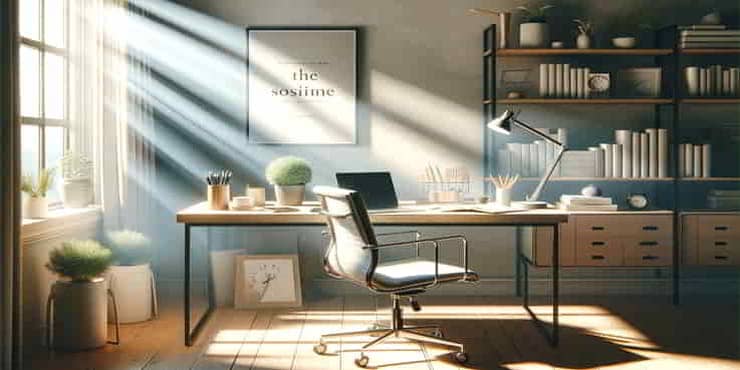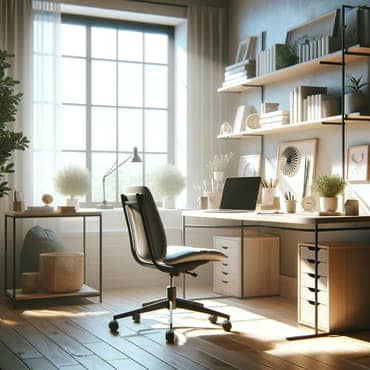Creating a Productive Workspace: Designing an Inspiring Environment

Estimated reading time: 7 Min
We spend a substantial portion of our lives working; Creating a productive workspace is essential for optimising creativity, focus, and a positive mindset.
A well-designed workspace can improve productivity exponentially.
A productive environment not only influences work efficiency but also plays a pivotal role in overall well-being.
Impact of Environment on a Productive Workspace
Scientific studies consistently highlight the impact of the physical environment on work performance.
Factors such as lighting, layout, and organisation directly influence concentration levels, job satisfaction, and, ultimately, productivity.
Recognising this correlation is the first step towards creating a workspace that supports professional success and personal satisfaction.
Ergonomics and Layout
Choosing the Right Furniture
- Ergonomic Chairs and Desks
Investing in ergonomic furniture is fundamental to a productive workspace. Ergonomic chairs and desks promote proper posture, reduce the risk of musculoskeletal issues, and contribute to overall comfort during extended work periods. - Adjustable Features
Flexibility is key when it comes to furniture. Adjustable features, such as height and tilt, accommodate diverse body types and working preferences. This adaptability ensures that the workspace caters to individual needs, promoting a healthier and more dynamic space.
Optimal Layout for Workflow

- Importance of Clear Pathways
A clutter-free and well-organized layout enhances a productive workflow.
Clear pathways contribute to easily moving about within the workspace, minimising distractions, and promoting a more focused work area. - Efficient Placement of Equipment
Strategic placement of essential equipment, such as computers, printers, and stationery items, contributes to an organised and efficient workflow.
An optimised layout reduces the time spent searching for tools and materials, allowing individuals to concentrate on their tasks with minimal disruptions.
Lighting and Colour Scheme
Natural Lighting Benefits
Natural light has been proven to positively impact mood and productivity.
Positioning a desk near windows or skylights allows for exposure to natural sunlight, can help reduce eye strain, and promotes a healthier circadian rhythm.
Artificial Lighting Considerations
- Task Lighting
Task lighting focuses on illuminating specific work areas, reducing eye fatigue, and enhancing concentration. Adjustable desk lamps or under-cabinet lighting are effective choices to supplement natural light sources. - Ambient Lighting
Ambient lighting sets the overall tone of the productive workspace. Choosing the right intensity and colour temperature helps create a comfortable and inviting atmosphere conducive to focused work. - Reflections
Position computer screens where they don’t reflect the ambient light in order to avoid eye strain.
Choosing a Soothing Colour Palette
- Impact of Colours on Mood and Productivity
Different colours evoke various emotions and reactions. Selecting a colour palette that aligns with the desired atmosphere is crucial. For example, calming blues and greens may promote a serene environment, while energetic yellows or reds can add vibrancy and motivation. - Coordinating Colours for a Balanced Atmosphere
Achieving a balanced colour scheme involves considering the overall aesthetic appeal. Harmonising colours across furniture, walls, and accessories contributes to a visually pleasing workspace that supports concentration and creativity.
Organisation and Decluttering
Importance of a Clutter-Free Space
A clutter-free environment is essential for maintaining focus and reducing stress.
Physical clutter can translate into mental clutter, hindering productivity. Establishing an organised system minimises distractions and fosters a sense of control over the workspace.
Organisational Tools and Storage Solutions
- Shelving and Cabinets
Incorporating ample storage through shelves and cabinets aids in keeping materials and supplies neatly arranged. This not only contributes to a cleaner workspace but also facilitates easy access to necessary items. - Desk Organisers and Trays
Utilising desk organisers and trays helps categorise and store smaller items. From pens and paper to cables and gadgets, these tools contribute to a tidy and productive workspace, allowing for a more focused and organised work routine.
Personalisation and Inspiration
Adding Personal Touches
- Plants and Greenery
Introducing plants into the workspace not only enhances aesthetics but also contributes to improved air quality. The presence of greenery has been linked to reduced stress and increased productivity, making it a valuable addition to any workspace. - Artwork and Decor
Personalising the space with artwork, photographs, or meaningful decor items creates a more engaging and inspiring atmosphere. These elements can serve as visual reminders of personal or professional achievements, motivating individuals during challenging moments.
Creating an Inspiring Atmosphere
- Motivational Quotes
Incorporating motivational quotes strategically placed within the workspace can serve as daily reminders of goals and aspirations. Whether on the walls or as desktop wallpapers, these affirmations contribute to a positive and focused mindset. - Vision Boards
Creating a vision board with visual representations of short-term and long-term goals provides a tangible and motivational tool. Placing the vision board within the workspace reinforces a sense of purpose and direction, encouraging sustained effort towards personal and professional objectives.
Integration of Technology
Electrical Supply and Efficient Cable Management
Make sure there are enough convenient electrical points available.
Managing cables and wires is crucial for both aesthetics and functionality.
Implementing cable organisers and concealment solutions prevents tangling and clutter, encouraging a clean and productive workspace.
Utilising Smart Technology
- Smart Lighting System
Integrating smart lighting systems enables individuals to customise and control lighting conditions based on personal preferences. This not only contributes to energy efficiency but also allows for personalised lighting setups tailored to specific tasks. - Organisational Apps and Tools
Leveraging technology through organisational apps and tools aids in task management, scheduling, and overall productivity. Whether using project management apps or digital calendars, integrating technology into the workflow streamlines processes and enhances efficiency.
Comfort and Well-being
The Importance of Comfortable Seating
Optimal seating contributes significantly to the overall comfort and well-being of individuals in a workspace.
Investing in ergonomic chairs with proper lumbar support and cushioning enhances comfort during extended work hours, reducing the risk of discomfort and pain.
Incorporating Break Areas

- Relaxation Zones
Designating specific areas for short breaks or relaxation promotes a healthy work-life balance. Comfortable seating, soft furnishings, and a calming ambiance can create a retreat within the workspace, allowing individuals to recharge and refocus. - Incorporating Nature Elements
Bringing elements of nature, such as indoor plants or natural materials, into break areas can contribute to stress reduction and improved well-being.
Nature-inspired spaces provide a refreshing contrast to the typical work environment.
Noise Control
Identifying Noise Sources
Understanding and identifying sources of noise within the workspace can help in creating a productive environment.
Common noise disruptors include office equipment, conversations, and external sounds.
Implementing Soundproofing Solutions
- Acoustic Panels
Installing acoustic panels on walls or ceilings helps absorb sound, reducing echoes and minimising overall noise levels. This is particularly beneficial in open office settings where sound can easily travel. - White Noise Machines
White noise machines or ambient sound generators can mask distracting noises, providing a consistent and neutral background noise that promotes concentration. These devices are especially useful in environments where complete silence is challenging to achieve.
Creating a Routine
Establishing a Consistent Schedule
Setting a daily routine establishes a structured work environment.
Consistency in start and end times, as well as designated breaks, helps create a sense of order and predictability, promoting overall productivity and time management.
Utilising Timed Breaks
- Pomodoro Technique
The Pomodoro Technique, involving short, focused work intervals followed by brief breaks, is a popular method to enhance concentration and prevent burnout. Incorporating timed breaks helps maintain mental freshness and sustained focus throughout the workday. - Stretching and Exercise Breaks
Integrating brief stretching or exercise breaks into the routine improves physical well-being. Simple desk exercises or short walks can boost energy levels, alleviate stiffness, and enhance overall health, contributing to a more vibrant and productive work environment. Incorporating short physical activity between Pomodoro sessions is my approach.
- Stretching and Exercise Breaks
Integrating brief stretching or exercise breaks into the routine improves physical well-being. Simple desk exercises or short walks can boost energy levels, alleviate stiffness, and enhance overall health, contributing to a more vibrant and productive work environment. Incorporating short physical activity between Pomodoro sessions is my approach.
Summary
In creating a productive workspace, various factors come into play, from ergonomic furniture and optimal lighting to personalisation and establishing routines.
The interconnectedness of these elements forms the foundation for a workspace that promotes focus, creativity, and overall well-being.
Recognising that each individual’s needs and preferences vary, it’s essential to encourage experimentation. Tailoring the workspace to personal habits and preferences empowers individuals to create an environment that truly enhances their unique work style.
The process of designing a conducive workspace is dynamic. As work requirements, technology, and personal preferences evolve, it’s important to embrace a mindset of continuous improvement.
Regularly assessing and adapting the workspace ensures it remains aligned with changing needs and promotes sustained productivity and satisfaction.
In conclusion, a thoughtfully designed workspace is a powerful tool that goes beyond mere functionality; it becomes a supportive and inspirational backdrop for professional and personal growth.
OK, so what have you done to personalise your workspace? Or if you have questions please use add a comment or use the contact form.
🙂
Richard






